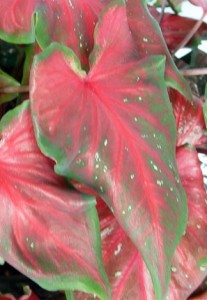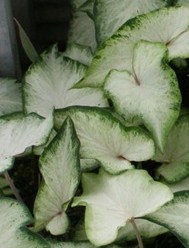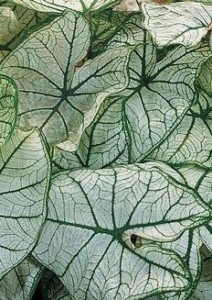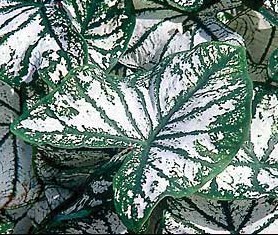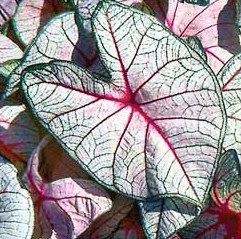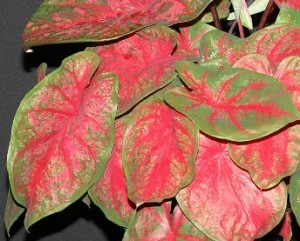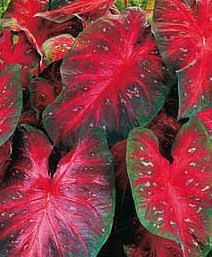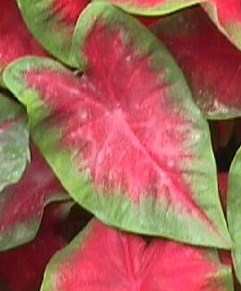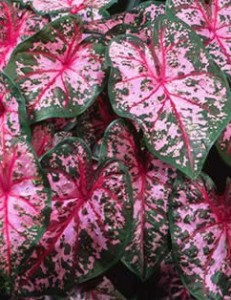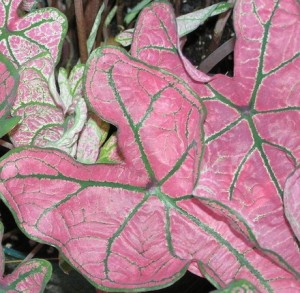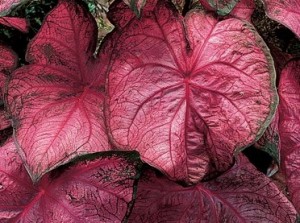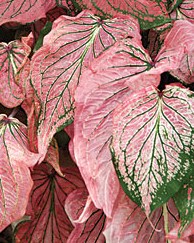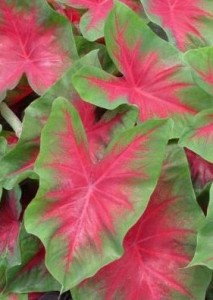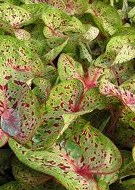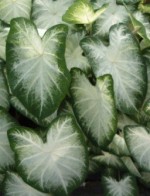
If you have a lot of shade caladiums are a good choice. Their large colorful leaves can brighten or enliven a dark area and lend a quiet ambiance to a shade retreat. Pair them with plants that have leaves or flowers that provide contrasting texture like astilbes or ferns and you will create a horticultural work of art. Impatients like the same conditions and can echo the colors of the caladium leaves. Fertile, moist soil is all they need to thrive in the shade. Caladiums are native to subtropical regions and so will need to be lifted and stored in all zones except 10 and 11. Click here to read my post on lifting and storing caladiums.
Caladiums vary in several ways, making some more desirable for certain areas than others. Here are some variations with examples of cultivars that might be considered.
Leaf Shape
Caladiums can be divided on the basis of leaf shape into two major groups based on leaf shape: fancy, and lance/strap.
-Fancy leaf caladiums have heart shaped leaves with petioles (stem like structure) that are attached on the back of the leaf. The 3 main veins in the leaves form a Y. The caladium ‘Aaron’ featured above is an example as is the caladium in the picture below showing the petiole attachment.
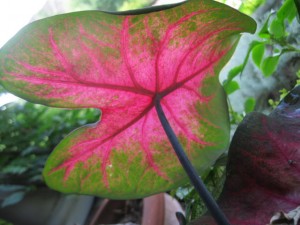
-Strap or lance leaf caladiums have leaves that are arrow shaped with the petiole attached at the edge of the leaf.
Height of Plant
This characteristic generally goes along with the leaf shape so you have to accept height and leaf shape as a pair. You may have to decide whether height or shape is more important to you and choose accordingly.
-Medium height caladiums usually have lance or strap shape leaves also identified as arrow shaped. They also produce more leaves, have a spreading habit, and tolerate sun and lower temperatures better than tall, fancy leaved caladiums.
-Tall caladiums are usually fancy, heart shaped leaves, produce fewer leaves, tend to be upright, and are less tolerant of sun and low temperatures.
Leaf Color
Leaves can be green, white, red (crimson, scarlet, rose), or pink. Most popular caladiums are red, pink, or white, with green appearing on the edge or in the veins.
White
White leaves may be combined with green, pink, or red.
‘White Wing’ has green edges.
‘Candidum’ has green edges and veins.
‘White Christmas’ also has green edges and veins but the effect is very different.
‘White Queen’ has green edges but red veins.
Red
Red leaf caladiums usually have green edges.
‘Scarlet Beauty’ has scarlet leaves with a caste of hot pink and olive green edges.
‘Red Flash’ features bright red leaves with dark green edges and bright pink spots and splashes. It may be as short as 12” but can grow to 18”.
‘Postman Joyner’ is considered red with green edges and grows 12-18″ tall.
Pink
Pinks may be pastel or bright shading to rose and crimson.
‘Carolyn Whorton features extra large pink leaves with green edges and splotches, and rose veins. Plants are vigorous and grow 18” tall.
‘Lord Derby’ has rose leaves with green veins and border. It grows 18” tall.
‘Fanny Munson’ has bright pink leaves with dark green edges. It stands 16”.
‘Pink Symphony’ boasts pale pink leaves with dark green veins and edges and only stands 14” tall.
‘Frieda Hemple’s’ vivid crimson leaves have such wide green margins perhaps the leaves are really green with crimson centers. Looks a lot like ‘Postman Joyner’.
Green
Green tends to be a trim color but sometimes it is hard to decide what is the main color and what is the secondary color as noted above . ‘Miss Muffet’, however, clearly offers chartreuse green with pink speckles.
The combinations of pinks, reds, greens, and white are endless so there is surely one to meet everyone’s needs and wants. By varying the color combinations and textures produced by the color effects it is possible to create a very interesting and beautiful planting in the shade. And don’t forget to cut a few leaves every now and then to use in flower arrangements. The leaves have a long vase life and are striking in a vase with flowers that grow in the sun as well as in the shade so you can experiment with new combinations.
